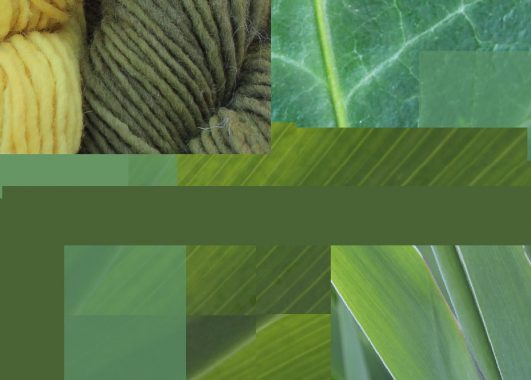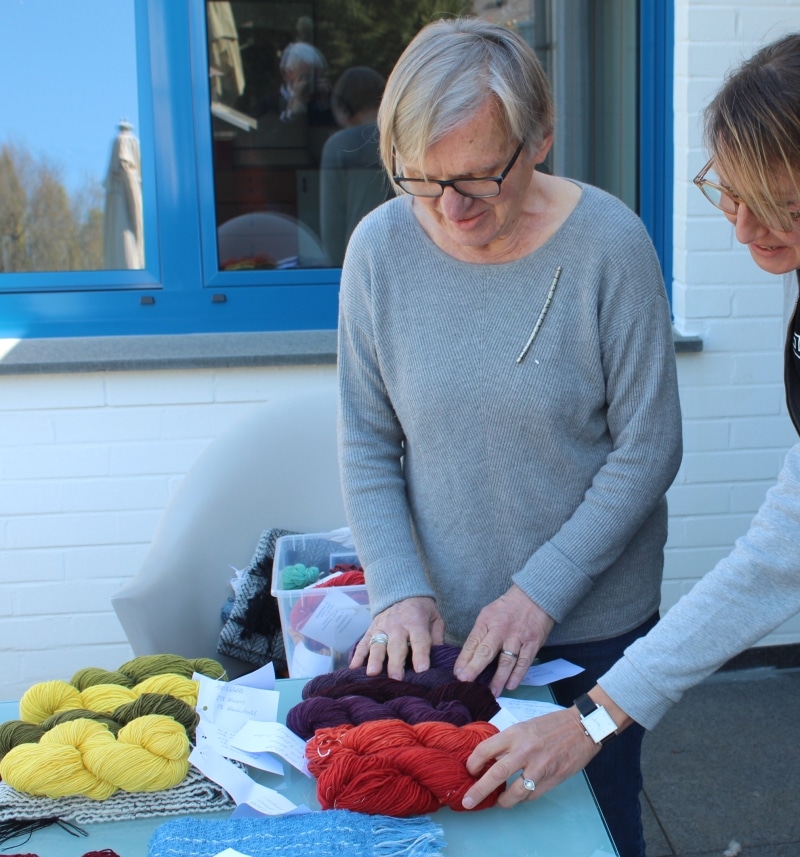
The secret of many plants!
How do I dye unique shades with materials from nature?
In recent years, dyeing with plants has once again become a trendy topic. This is not a surprise to Dorothea Flaskamp. Even after more than 40 years of dyeing with plants, she talks enthusiastically about her dyeing workshops. The next one is in June. As always, the workshop takes place in her large natural garden in Linnich, Germany.
In her workshops on 'Dyeing naturally with plants', she explains which leaves, flowers, roots, and barks dye natural fibres like wool and silk into beautiful colors. 'Learning by doing' is her motto and so the participants experience how important the preparation of the dyeing material is - the pickling of the fibers, the ratio of dyeing material to the dyeing pulp, the appropriate temperature of the dye decoction and that the air only develops the blue dye with indigo. These are only one of many tips and tricks that Dorothea likes to pass on to the participants.
Dyeing naturally with plants: the nettle
What color shade do you dye with nettle? This question puts a big smile on Dorothea’s face:
“One Color? If I could give you an easy answer on this. The picked nettle leaves can be freshly cooked into a decoction – or used in dried form. Are they picked in spring or autumn? Is the earth nutrient-rich or has it rained a lot? These are all factors that influence the yellow-green hues. But it is always a wonderful natural color. The dye process with nettle can create about 20 different tones.”
At the beginning of her work with natural colors, Dorothea documents and researches a great deal. Since quite some time she has stopped doing this. Now she just enjoys the dying process. And of course, she likes to share her knowledge and expertise with others.
How to dye a shade of blue with natural materials?
Before the synthetically produced indigo is used as a blue dye, the woad (Isatis tinctoria) is the plant that gives the fabrics a blue color tone in Europe. Not the bright yellow flowers of the woad are used for the dye but the leaves contain the dying material. Entire regions in France, England and Germany have benefited from the cultivation and processing of this special plant. The unique blue tone cannot only be found in textiles but is used for wood coloring and plaster paints. The plant and the blue hues add a unique colored look to these local regions. Some village communities in Thuringia in the eastern part of Germany are again cultivating the woad as a dyeing plant. Recent studies show also that the woad extract is a perfect natural wood preservative. Yet another secret of this plant.
"Even a 100 years ago many plants grew in kitchen gardens, in the forest and on green strips around the fields. Unfortunately, they have disappeared in the course of conventional agricultural cultivation and synthetic pigment production. They may also not be collected for nature conservation reasons. In one's own garden, for example, dyer's bugloss (Reseda luteola) and madder (Rubia tinctorium) can be grown. Carrot greens, walnut leaves, onion peels and rhubarb roots can also be used for dyeing."
Fast Fashion vs. Slow Fashion
Like Dorothea, major ‘green’ clothing manufacturers also source some of their natural dyes from India. She imports natural indigo and madder from India, and cochineal louse from the Canary Islands. Many other natural dying materials still come from Europe. The natural dyes are much more expensive than chemical dyes. They are also not available in sufficient quantities for the global Fast Fashion textile production. Many developing countries still have lower environmental standards. So the chemically produced dyes with toxic contents and metallic additives cause health problems for the workers on site. Therefore also the end consumer may not fully enjoy these synthetic dyed textiles and garments. Dorothea knows these facets of the textile industry. She works as a textile engineer in German institutes after her university degree. Part of her work is to test industrially dyed textiles.
En vogue! Natural dyes for apparel
In the 1980s, organic farms and food shops establish themselves in Germany. The first ecological textiles create an awareness of limited natural resources. Dorothea is also enthusiastic about this new trend. She starts her first dyeing experiments with natural colours and materials. She researches and documents her work and imparts her newly gained knowledge in various courses. She establishes her small manufactory for textile products made from 100% wool felt.
Dorothea discovered today's approach 'away from buying fast fashion' a long time ago. Of course, she keeps the treasure of her first self-dyed and sewn favorite jacket carefully wrapped up.
"Dyeing wool with my hands, weaving a fabric out of it and sewing a jacket out of this material, I always found this very appealing. This process has a special charm and still excites me!"
What wishes do you have for the next few years?
"I like to continue with my work. To advise my customers on the choice of dyes and other products. To organize and conduct my popular workshops. I simply like to share my enthusiasm for nature's dyeing treasures. As long as possible I want to continue processing materials with my own hands. And I still want to share this with many people. I just bought two new looms and I am in the process of trying them out. There is also a semi-mechanical / electronic one. Now I don't have to tie the shafts bent over on the floor. What a relief." She adds with a smile.
Dyeing wool into beautiful shades of blue with her indigo dyeing recipe and weaving a piece of fabric on her loom still inspires Dorothea. The result is a sustainable favourite piece like this scarf, which protects and keeps her warm on a cold winter's day.
Her approach to working 'in and with' nature is evident in many ways. Her garden is a green oasis used to facilitate her dye workshops. The greenhouse, the fruit- and vegetable garden and the chicken house provide all organic produce. Of course, a variety of special colors can be discovered all around her natural garden.

Name: Dorothea Flaskamp
She is:
Textile engineer, Natural Color expert and offers many different textile workshops
Her studio is located in:
Linnich, near the cities of Aachen, Cologne und Dusseldorf, Germany
She likes:
working in her vegetable and perennial garden, city trips in Germany, exhibitions of 'Classical Modernism', the tour at the art academy in Düsseldorf, when the students have their annual exhibition, photography and taking pictures
She admires:
all doctors who work for 'Doctors without Borders' and in crisis areas
Her WIASOLA tip:
"Be curious! Always look for and take on new challenges "
Her favorite Museums and Architecture:
Museen Langen Fondation auf der Raketenstation Hombroich, Neuss, near Dusseldorf, Germany, designed by Tadao Ando
Museum FONDATION BEYELER CH-4125 Riehen/Basel, Switzerland, designed by Renzo Piano
This small but very special Museum about German stained glass art: ‚Deutsches Glasmalerei-Museum‘ in Linnich where Dorothea lives!
To be found under:
Her workshops: